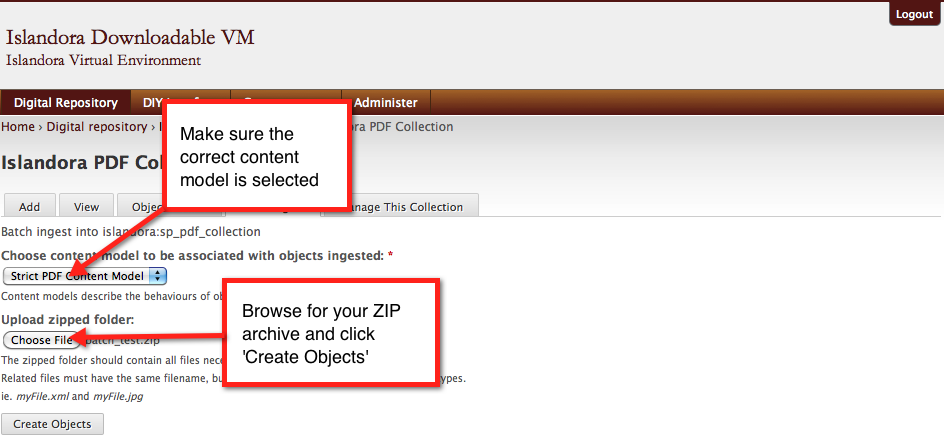The batch ingest module allows you to add several files, metadata records, or a combination of both to a collection by packaging the items in a ZIP archive. For a detailed overview of the module, please see the Batch Ingest page in Chapter 5 - Islandora Modules.
You can add files without metadata to a ZIP archive and ingest them via batch ingest - basic MODS and DC metadata records will be created using the filenames as titles. The files in the ZIP archive must be associated with an existing content model on ingest - all solution pack content models are supported (except the book solution pack). For this tutorial we'll batch ingest some TIFF files using the Large Image Solution Pack.
1. Compress the files as a ZIP archive
Compress the TIFF files and name your ZIP file - in this case, tiff_test.zip.
2. Navigate to the Target Collection
Navigate to a collection that has been associated with the large image content model. In this case, we'll use the default Islandora Large Image Collection.

3. Batch Ingest the ZIP File
Make sure the large image content model is selected, and click the 'Batch Ingest' tab and browse for your ZIP file. Click 'Create Objects' to proceed.

4. View Your New Objects

The batch ingest module also allows you to add metadata records without accompanying binary files. You can add either DC or MODS metadata XML files - DC metadata will be saved and crosswalked to MODS, and MODS metadata will be saved and crosswalked to DC. A separate object will be created for each XML file included in the ZIP archive.
Your metadata records must be in either MODS or DC format and saved as XML files. The batch ingest module will determine whether the files are MODS or DC programatically on ingest, so you don't need to manually specify which metadata schema you're using. One object will be created for each valid XML file in the ZIP archive; the filenames are not important because the title and other relevant information will be drawn from the metadata itself.
The following are examples of valid DC and MODS metadata records for audio files:
MODS
<mods xmlns="http://www.loc.gov/mods/v3" xmlns:mods="http://www.loc.gov/mods/v3"
xmlns:xlink="http://www.w3.org/1999/xlink">
<titleInfo>
<title>Test Audio</title>
<subTitle/>
</titleInfo>
<name type="personal">
<namePart>Test Author</namePart>
<role>
<roleTerm authority="marcrelator" type="text"/>
</role>
</name>
<typeOfResource>Sound Recording</typeOfResource>
<tableOfContents/>
<genre>anthems</genre>
<originInfo>
<dateIssued>2011-12-21</dateIssued>
<publisher/>
<place>
<placeTerm authority="marccountry"/>
</place>
<place>
<placeTerm type="text"/>
</place>
</originInfo>
<language>
<languageTerm authority="iso639-2b" type="code"/>
</language>
<abstract>A test audio file.</abstract>
<identifier/>
<physicalDescription>
<form authority="marcform">sound recording</form>
<extent/>
</physicalDescription>
<note/>
<subject>
<topic/>
<geographic/>
<temporal/>
<hierarchicalGeographic>
<continent>North America</continent>
<country/>
<province/>
<region/>
<county/>
<city/>
<citySection/>
</hierarchicalGeographic>
<cartographics>
<coordinates/>
</cartographics>
</subject>
</mods>
DC
<oai_dc:dc xmlns:oai_dc="http://www.openarchives.org/OAI/2.0/oai_dc/"
xmlns:dc="http://purl.org/dc/elements/1.1/" xmlns:xsi="http://www.w3.org/2001/XMLSchema-instance"
xsi:schemaLocation="http://www.openarchives.org/OAI/2.0/oai_dc/ http://www.openarchives.org/OAI/2.0/oai_dc.xsd">
<dc:title>Test Audio</dc:title>
<dc:subject/>
<dc:subject>----</dc:subject>
<dc:description/>
<dc:description>A test audio file.</dc:description>
<dc:description/>
<dc:publisher/>
<dc:contributor>Test Author ()</dc:contributor>
<dc:type>anthems</dc:type>
<dc:format/>
<dc:format>sound recording</dc:format>
<dc:identifier>islandora:1240</dc:identifier>
<dc:language/>
<dc:coverage/>
<dc:coverage>North America--------</dc:coverage>
<dc:coverage/>
<dc:coverage/>
</oai_dc:dc>

3. Choose a Collection to Create Your Objects In
You can either navigate to an existing collection or create a new collection. You will need to associate your new objects with a content model, so make sure the relevant content model has been added to your collection.
4. Batch Ingest the ZIP Archive
Click the Batch Ingest tab and make sure the relevant content model is selected. Browse for the ZIP archive and click 'Create Objects' to proceed. 
A progress bar will indicate that objects are being created.

5. View Your Newly Created Objects
Your new objects will appear in the collection view. Click on an object and verify that the metadata has been successfully added.

The third batch ingest option is adding files with associated metadata. Each batch of files may only be associated with a single content model, so if you have multiple content types you will need to do a separate batch for each type.
In order to associate an XML metadata record with the relevant file (audio, image, PDF, etc.) they must share the same filename (excluding the file extension). For example, a directory with three PDF files and associated MODS XML files would look like this:

2. Add the Binary and XML Files to a ZIP Archive
Select all the files and add them to a ZIP archive.
3. Choose a Collection to Create Your Objects In
You can either navigate to an existing collection or create a new collection. You will need to associate your new objects with a content model, so make sure the relevant content model has been added to your collection.
4. Batch Ingest the ZIP Archive
Click the Batch Ingest tab and make sure the relevant content model is selected. Browse for the ZIP archive and click 'Create Objects' to proceed. 
A progress bar will indicate that objects are being created.

5. View Your Newly Created Objects










